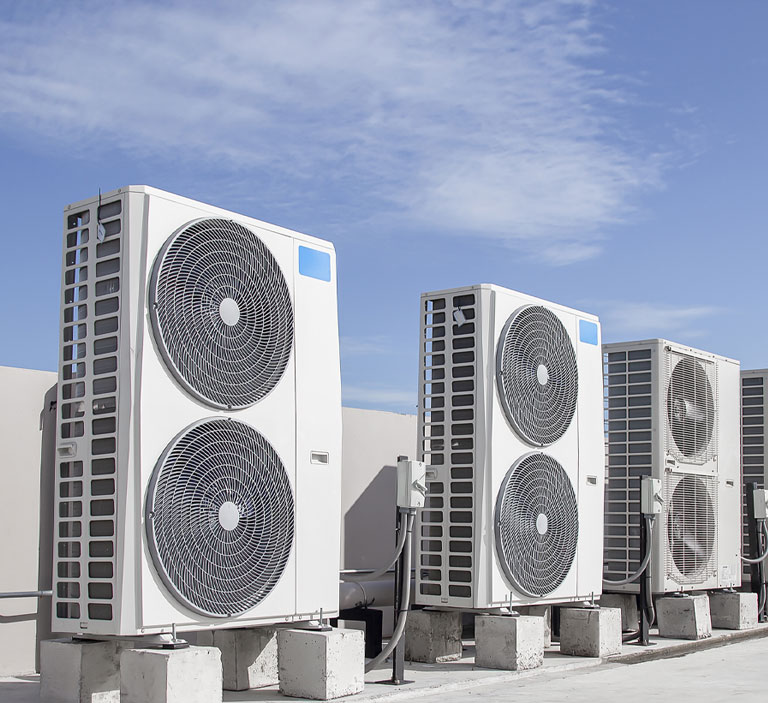Everyone knows there will always be coworkers who think it’s too cold and those who think it’s too warm. As facilities manager or a commercial property, you won’t keep everyone happy but what you can do is make sure the HVAC (heating, ventilation, and air conditioning) system in your building is running reliably and efficiently. If the current system is causing temperatures to fluctuate wildly – leading to employee and customer discomfort and distraction – is causing poor air quality or is requiring frequent repairs, it will have an impact on your company’s profitability.
If your company is leasing the workspace, it is often the landlord’s responsibility to ensure the HVAC system is working properly.
Whether you are managing a property that is leased or owned, it’s important to have a foundational knowledge of HVAC systems. This article will cover:
- Commercial HVAC system components
- Types of commercial HVAC systems
- The importance of regular maintenance and maintenance tips
- Signs of system aging
- Retrofitting options
- Indoor air quality monitoring methods
Commercial HVAC System Components
The components of a commercial HVAC system work together to regulate indoor temperature, humidity, ventilation, pressure and air quality. Here are the pieces of equipment that make it all happen:
- Heating and Cooling Source: These components include heat pumps, boilers, and chiller, working to generate hot or cold air.
- Air Handler: The air handler is comprised of a blower, heating or cooling coils and filters. Its job is to take the conditioned air and circulate it throughout the building.
- Indoor Units: Indoor units distribute the conditioned air to specific areas (zones) within the building, usually via a system of ductwork or as a ductless unit.
- Outdoor Units: Outdoor units hold the condensers and compressors that are responsible for releasing heat (when the system is providing cooling inside) or absorbing heat (when the system is providing indoor heating).
- Ductwork: Ducts are used to transport air to different parts of the building. The ducts must be of good quality and sealed correctly to ensure system efficiency and good air quality.
- Control System: The control system is the “brain,” with the thermostats, sensors and a central controller that manages the operation of the HVAC system.
Types of Commercial HVAC Systems
Commercial buildings have a range of HVAC options, each with its own set of pros and cons. Here’s an overview of the most common systems. Use this as a guide to choose which best suits your facility.
- Split System: A split system consists of an indoor unit – with an evaporator and fan – and an outdoor unit containing the compressor and condenser. There is a slight tradeoff on energy efficiency when compared to other options but this is still an ideal and economical choice for smaller commercial spaces.
- Multi-Split System: Think of this as a network of single-split systems, with multiple indoor units connected to a single outdoor unit. This is the best choice for a facility with many small rooms
- Variable Refrigerant Flow (VRF) System: A VRF system offers flexibility and energy efficiency. Installation can mean a more significant upfront expense but this type of system is ideal for larger commercial buildings, allowing for simultaneous heating and cooling across different zones.
- Rooftop Units: Rooftop units are, as their name indicates, installed on the roof of the commercial building, making them space-saving and easy to access and maintain. They differ from packaged units in that they only contain the cooling system.
- Packaged Units: Packaged units contain both heating and cooling systems in a single unit. Also installed on rooftops, these systems are easy to maintain and are an excellent choice for larger commercial buildings.
- Heat Pumps: Heat pumps are an environmentally friendly, cost-effective choice, providing efficient heating and cooling. Their only drawback is the potential for inefficiency in extreme climates.
- Boilers and Chillers: Boilers – providing heating – and chillers – providing cooling – are best used in factories, industrial spaces and even health care facilities.
How Often Should You Service Your HVAC?
Regular maintenance is the key to the longevity and reliability of your commercial HVAC system. It’s recommended to schedule professional maintenance at least twice a year – once before the cooling season and once before the heating season. During these visits, technicians will inspect and clean components, replace filters, and address any potential issues.
How Is a Commercial HVAC System Controlled?
Control systems for commercial HVAC units have become increasingly sophisticated, using digital thermostats, sensors, and programmable logic controllers (PLCs) to monitor and control various aspects. This provides additional flexibility and precision, allowing you to set temperature schedules, monitor energy consumption, and receive alerts for system malfunctions, all leading to improved energy efficiency and comfort.
Signs It’s Time to Replace Your HVAC System
Here are some signs that it might be time to consider replacing your HVAC system:
- Increased Energy Bills: A sudden spike in energy bills could indicate that your HVAC system is struggling to maintain efficiency.
- Frequent Repairs: If you find your system needs to be repaired more often, it may be time to pivot that spend to a new system.
- Inconsistent Heating or Cooling: Eventually the system will start to underperform, providing uneven temperature distribution or having difficulty maintaining the desired temperature.
- Noisy Operation: Loud and unusual noises, like banging or clanking, can be a sign of worn-out components.
- Reduced Air Quality: If you’re noticing a deterioration in your indoor air quality, it could be due to an aging HVAC system that’s no longer effectively filtering the air.
Retrofitting HVAC
The process of adding an HVAC system to a building that does not currently have one is called retrofitting. It is possible to add an HVAC system to an existing commercial building but your options will depend on the layout and structural considerations of the building.
These are the best options for retrofitting and HVAC system:
- Ductless Mini-Split Systems: These systems are a popular choice for retrofitting because they require minimal ductwork and can be installed in individual zones.
- High-Velocity Systems: These systems use smaller, more flexible ducts to allow for a faster flow of hot or cold air. This is a good choice for older buildings with limited space for ductwork.
- Hydronic Systems: Hydronic heating and cooling systems are also known as radiant systems, using pipes to circulate hot or cold water to provide heating and cooling.
- Ductwork Installation: Depending on the building, it may be possible to install ductwork for the new HVAC system. Keep in mind that this is a more costly and extensive process than the other options provided.
The best first step is to consult with an HVAC professional to determine the best solution for your specific needs.
Monitoring HVAC System Air Quality
While comfort is important, maintaining good indoor air quality is crucial for the health of the employees and customers spending time in the building. Here are some ways you can monitor and improve the air quality within your commercial HVAC system:
- Regular Filter Replacement: Replace the air filters as recommended to remove dust, allergens and contaminants from the air.
- CO2 Sensors: Carbon dioxide sensors monitor indoor air quality and adjust ventilation as needed to maintain appropriate CO2 levels.
- Humidity Control: Prevent mold growth and ensure comfort by maintaining proper humidity levels.
- Air Purification: Consider adding air purifiers or UV germicidal lamps to eliminate bacteria and viruses from the air.
- Regular Maintenance: Regular maintenance of the HVAC system, especially regular cleaning and inspection of the components that impact air quality.
Choose What Works Best for Your Needs
It’s easy to feel overwhelmed with so many options to choose from. The answer lies in selecting the HVAC system that works best for your building and its occupants, performing regular maintenance, and paying attention when signs of age or inefficiency start to occur.


